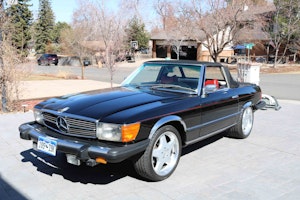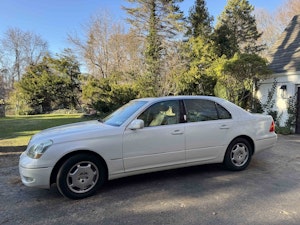Media | Articles
Aston Martin’s last great prototype could become the most expensive British car ever sold at auction
In 1959, behind first-place Carroll Shelby and co-driver Roy Salvadori, and the second-place duo of Maurice Trintignant and Paul Frere, Aston Martin narrowly squeezed out fierce rivals Ferrari and Porsche to score a 1-2 finish at the 24 Hours of Le Mans. It was a victory Aston Martin had coveted since 1928.
Just two weeks prior, the Aston Martin DBR1 won the 1000 Kilometers of Nürburgring, Stirling Moss’ third victory there, as he broke his own lap records an astonishing 16 times in his first 17 laps. In September ’59, Shelby, Moss, and Jack Fairman drove the DBR1 to a win at the RAC Tourist Trophy at Goodwood, and Aston Martin introduced its latest, greatest road car, the DB4 GT, which upon its debut was the fastest production car in the world. Not surprisingly, Aston seized the World Sportscar Championship in ’59. It was a banner year indeed.
Then, prior to the 1960 season, team owner David Brown shut it all down.
Fall from grace
20180717171313)
Why? Brown wanted to focus on the DB4 GT. And compared to the already intriguing DB4, the GT was a world apart: Aston Martin Racing manager John Wyer—he of Gulf and GT40 fame, and everything else—commissioned the DB4 GT to be a distillation of everything the team had learned from nearly 20 years at Le Mans.
Marketplace
Buy and sell classics with confidence
Aston’s engineers, led by Ted Cutting, removed five inches from the DB4’s standard wheelbase. Ditched the rear seats. Wrapped the body in lightweight aluminum alloy. Streamlined the nose to resemble that most famous of DBs, James Bond’s own. Finally, they gave it one of the most advanced engines of its day: a 3.8-liter straight-six with three Webers and two spark plugs per cylinder, rated at a sky-high 9:1 compression.
From the factory it produced 302 horsepower. It could reach 151 miles per hour. From a stop it could hit 100 mph—smacking 60 mph in six seconds—and back to zero in 20 seconds. Upon its debut, Moss took it to the International Trophy Meeting at Silverstone and set a pole position, set a lap record, and won the whole thing. Not a bad start. It was, in Wyer’s dry wit, “a cheap and cheerful GT car.”
20180717171536)
That achievement was a hell of a reason to quit racing. But the unspoken reason was a second year of failures in Formula 1. Aston Martin had been working on a Grand Prix entry since 1957, but by the time the DBR4 F1 race car debuted in 1959, it was already outdated: even with Salvadori and Shelby, the DBR4 didn’t earn a single point. By the end of the 1960 season, Aston’s vision of repeating its sports car successes there was gone, and all the cars went to privateers.
It didn’t take long for Brown and company to realize that they had made a mistake.
Back in the swing of things with DP215
20180717171255)
Design Project 212 was supposed to be Aston Martin’s return into sports car racing. It was a revamped DB4 GT: longer, sleeker, and more aerodynamic, resembling Aston’s interpretation of an E-type Lightweight. Or maybe an Alpine A110. DP212 entered the 1962 Le Mans with Richie Ginther and Graham Hill, who bowed out from mechanical issues seven hours in.
DP214 sought to fix all of its predecessor’s problems, namely rear-end lift at speeds of up to 175 mph, solved with a Kamm tail. Two were built for the 1963 Le Mans, but neither finished.
And then came the DP215. This would be the last race car built by Aston Martin until the modern era, the pinnacle of an evolution that had begun with the company’s first Le Mans entry in 1928, and a complete redesign of the formula. For the last great evolution, DP215 took two months to build, and it had to cost almost nothing to do so.
In May, two months before Le Mans, Wyer sent the team a memo: DP215 was to be ready to enter the Prototype class. Oh, and the budget was 1500 pounds—by modern-day standards a ludicrously low sum.
20180717171241)
Aston Martin’s famed engine designer Tadek Marek was originally to equip the DP215 with an early version of his V-8, but instead, it took on the largest incarnation of the DB4 GT’s straight-six, now displacing four liters and producing 323 horsepower. Cutting used wind tunnel testing to sort out the car’s aerodynamics, as well as balancing the car by pushing that six-cylinder back by 10 inches. During practice, Phil Hill and Lucien Bianchi drove the DP215 to 198 miles per hour on the Mulsanne Straight, smashing the 300-kph (186-mph) battier.
It was faster than every Ferrari on the field, by as much as 12 seconds a lap over the 250 GTOs. When the race started, Hill leapt to first place and held off the Ferraris, as promised. Then, two hours in, the transmission blew and DP215 was finished.
An ignoble fate indeed for Aston Martin Racing. At Reims, the transmission blew again, with Jo Schlesser driving, and then Wyer quit, going off to Ford (as we remember 50 years later) to accomplish great things. Three surviving DPs went to privateers. The doors closed on Aston Martin Racing for good this time, and it would take decades for a program to return. In 1966, a Bedford van crashed into DP215 while it was testing on the M1 motorway, and in an effort to avoid publicity, Aston Martin quietly sold the car for scrap.
DP215 restored
20180717171358)
Eventually, DP215’s fortunes fared better. Its restoration took the greater part of four decades, and Cutting was brought in to resurrect the drivetrain as he had once intended it, stronger transmission and everything. It took a while, but the original engine was sourced and rebuilt, running strong with over 300 horsepower.
At RM Sotheby’s Monterey auction this year, the Aston Martin DP215 prototype will go across the block. It is anybody’s guess how it will fare. The most expensive British car ever sold at auction was the DBR1 race car with which Moss performed miracles at the Nürburgring; last year at Monterey Car Week, it sold for $22.6 million.
“I’ll be surprised if [the DP215] sells for more than the DBR1,” Hagerty auction editor Andrew Newton says. “But then again, in that room there’s gonna be those buying Ferrari GTOs, and significant Ford GT40s. There’s going to be so much money in that room.”
DP215 is far more obscure than either of those icons. Having never won a single race, it serves as both the apex and nadir of a once-great program, and all of the dashed dreams that come with it.
20180717171428)
20180717171443)
And it’s rare. More so than a GTO, more than a Cobra or Daytona Coupe, more even than the Jaguar E-type Lightweight, being formerly the most expensive British car ever sold. And it is significant because it does represent the end of a run. It’s also fast: over 300 horsepower and a near-200-mph top speed in 1963 is a British moonshot, a reflection of how Aston Martin’s roadgoing GTs sacrifice absolutely nothing.
Aston Martins have piqued collectors’ interests for the past few years, enough to call it a trend. Witness the DB4 GT Zagato that sold for $13 million at the Goodwood sale at Bonhams. “People were saying that Zagato was a $20 million car, and Bonhams was being conservative, hinting more at $14 million,” Newton says. “Seems like it was close enough.”
20180717171414)









